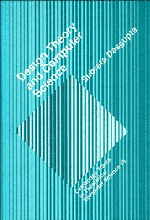Book contents
- Frontmatter
- Contents
- Preface
- Acknowledgements
- Part I The Architectonics of Design
- Part II Design Paradigms
- 6 The Concept of a Design Paradigm
- 7 The Analysis–Synthesis–Evaluation Paradigm
- 8 The Formal Design Paradigm
- 9 The Theory of Plausible Designs
- 10 Design and Artificial Intelligence
- 11 Algorithms for Design
- Part III Design and Science
- References
- Index
6 - The Concept of a Design Paradigm
Published online by Cambridge University Press: 10 February 2010
- Frontmatter
- Contents
- Preface
- Acknowledgements
- Part I The Architectonics of Design
- Part II Design Paradigms
- 6 The Concept of a Design Paradigm
- 7 The Analysis–Synthesis–Evaluation Paradigm
- 8 The Formal Design Paradigm
- 9 The Theory of Plausible Designs
- 10 Design and Artificial Intelligence
- 11 Algorithms for Design
- Part III Design and Science
- References
- Index
Summary
INTRODUCTION
This chapter initiates and serves as a preamble to a systematic discussion of several design paradigms. The concept of a paradigm is central, not only to this (the second) part of the book but also to the discussion of the relationship between design and science in Part III. It is, thus, of some importance to specify as exactly as possible what I mean when I use the terms ‘paradigm’ and ‘design paradigm’ in this work. The necessity for such clarification becomes specially urgent given the fact that in certain intellectual circles the word ‘paradigm’ has assumed the unfortunate status of a cult-word.
The present chapter also serves a second, less obvious, function. And that is, to demarcate the fundamentally descriptive spirit of the preceding chapters from the pronounced prescriptive character of the chapters to follow.
The discipline of design is necessarily Janus-faced. On the one hand the act of design is a cognitive and an intellectual process. Hence any theory of design must, at least in part, view design processes as natural processes that harness the capabilities inherent in, and are in turn harnessed to the limitations imposed by, human nature and intellect. A theory of design must at least in part be a cognitive theory and, therefore, descriptive in nature. Much of Part I was precisely that; in particular, the notion that design is an evolutionary phenomenon is a descriptive, empirical proposition – a consequence of the inherent bounds of our ability to make rational decisions.
- Type
- Chapter
- Information
- Design Theory and Computer Science , pp. 133 - 144Publisher: Cambridge University PressPrint publication year: 1991



